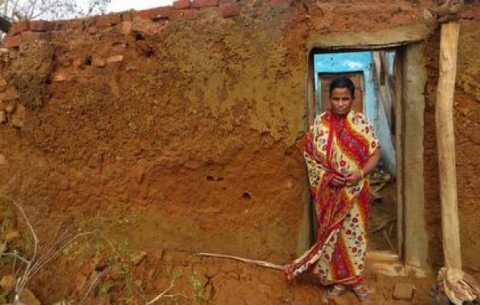Odisha, India - Investment in Risk Reduction Pays Off

An Odisha resident stands outside her house after it was hit by Cyclone Phalin.
Cyclone Phalin struck the coast of the Indian State of Odisha in October 2013 and affected more than 13 million people, including almost one million who had to be evacuated. It damaged 420,000 homes and is estimated to have cost in excess of US$700 million. This figure would be higher if not for Odisha's strong disaster management record, according to a leading urban activist based in the State capital of Bhubaneswar, pointing to the need to continue developing policy, technical and institutional capacities and mechanisms for disaster risk management, with a disaster risk reduction perspective.
Dr Piyush Ranjan Rout, who is the co-founder and executive director of the Local Governments Network and an advocate for the Making Cities Resilient Campaign, said the focus on accountability and reducing disaster risk avoided an even worse outcome. "Most of our towns are part of the UNISDR Campaign and the successful management of [Cyclone] Phalin highlighted the effectiveness of investments made over the last ten years. However, the still exorbitant economic losses experienced indicate strongly that in the future, both the national and state governments have to focus more on reducing economic exposure."
Included in the cost of recovery is US$39 million in school repairs and rehabilitation of the education system. This budget line will address the 5,825 schools that were damaged. The State government announced: "Funds will be provided for repair and restoration of school and college buildings based on priority."
“Most of our towns are part of the UNISDR Campaign and the successful management of [Cyclone] Phalin highlighted the effectiveness of investments made over the last ten years. However, the still exorbitant economic losses experienced indicate strongly that in the future, both the national and state governments have to focus more on reducing economic exposure.”
- Dr Piyush Ranjan Rout, co-founder and executive director of the Local Governments Network and an advocate for the Making Cities Resilient Campaign
UNISDR's 'Making Cities Resilient Campaign'
UNISDR launched the Making Cities Resilient Campaign in 2010 and through it has developed a global network of more than 2,500 local governments committed to reducing risk and building more resilient cities. These local governments represent cities of different sizes, characteristics, risk profiles and locations. Their efforts are reinforced by a supportive group of partner organizations.
The Campaign’s focus is on disaster resilience – that is, the ability of a city to plan for, mitigate, respond, recover, adapt and grow after major in the light of its unique physical, economic, environmental and social circumstances. On a spectrum ranging from chronic stresses (environmental, social or economic imbalances) through to acute stresses, disasters are at the acute pole, but may be exacerbated by a background of chronic stress – where for example upstream deforestation increases the propensity for as hooding, or where economic imbalances hinder the recovery process.
“It is clear that the risk in cities is growing faster than our ability to reduce them. We need to innovate and ensure that solutions, tools and methods for resilience building are not only available, but also accessible. We need to accelerate resilience building at the local level, and this partnership will contribute to do this.”
- Margareta Wahlström at the Third UN Conference on Disaster Risk Reduction in Sendai, Japan in March, 2015.
